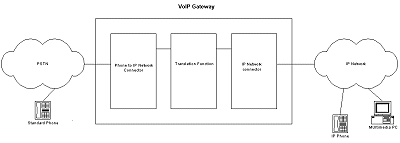Introduction:
As we all know the Internet spans the whole world and you can find a place
to connect to the Internet at the most strange places in the world (i.e. easyinternet
from EasyEverything). Today many websites are sound enabled. Voice over IP uses
the IP protocol to send audio between one or more computers in real time, so
that users can converse. When Vocaltec introduced their first IP telephony software
in 1995, they caught the world’s attention. VoIP has become one of the hottest
items at the moment, but VoIP wouldn’t be that hot if there was no connection
between the Internet and the traditional PSTN networks. If there where no connection
you have two separate networks and that is not what we were waiting for. To
make a connection between the two networks you use a gateway.
What does a gateway:
As we all know the Internet spans the whole world and you can find a place to connect to the Internet at the most strange places in the world (i.e. easyinternet from EasyEverything). Today many websites are sound enabled. Voice over IP uses the IP protocol to send audio between one or more computers in real time, so that users can converse. When Vocaltec introduced their first IP telephony software in 1995, they caught the world’s attention.
By bridging the traditional circuit-switched telephony world to IP related
networks, gateways offer the advantages of VoIP to the most common, cheapest,
most mobile, and easiest-to-use terminal in the world : the standard telephone.
Gateways overcome another significant VoIP problem: addressing. To address a
remote user on a multimedia PC or IP-phone, you must know the user’s IP address.
To address a remote user with a gateway product you only need to know the user’s
phone number.
How does it work:
Picture 1 represents a simple layout of a gateway.
Picture 1: Simple Gateway scheme
On the Phone to network connection the gateway connects to the PSTN. You can
connect any phone you like at this side. At the other side the gateway connects
to an IP network, this side can communicate with every well equipped PC or IP
phone in the big world of communication.
The gateway takes the standard telephone signal ( if it is analog, the gateway
digitizes it) and compresses it significantly. After that the gateway makes
the packets, which are needed to make use of the IP protocol and routes it to
the destination on the IP network. The gateway also reverses the operation for
the signal, which comes from the IP network and want to go to the PSTN network.
It is important that the both operations take place in the same time to allow
a full-duplex (two way) conversation.
Two very important functions of an gateway are:
- Reduce latency, humans can tolerate 250 msec of latency before it has a
noticeable effect, so the gateway must can reduce this latency otherwise the
connections will sound like a traditional call routed over a satellite circuit. - Echo cancellation
Summary:
In the article above I described the most basic features of the gateway and
what they mean in the VoIP world.


